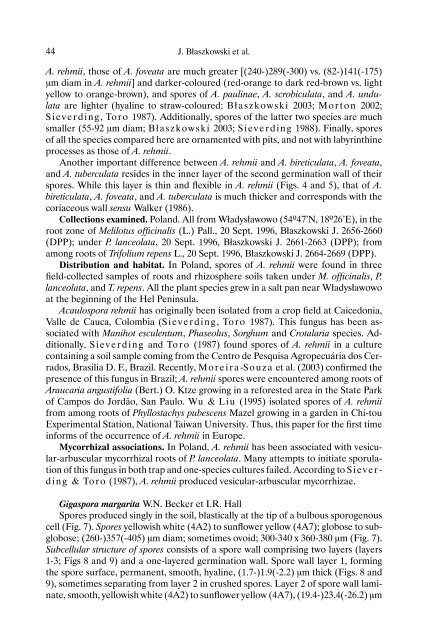Acaulospora rehmii and Gigaspora margarita, arbuscular ...
Acaulospora rehmii and Gigaspora margarita, arbuscular ...
Acaulospora rehmii and Gigaspora margarita, arbuscular ...
Create successful ePaper yourself
Turn your PDF publications into a flip-book with our unique Google optimized e-Paper software.
44 J. Błaszkowski et al.<br />
A. <strong>rehmii</strong>, those of A. foveata are much greater [(240-)289(-300) vs. (82-)141(-175)<br />
μm diam in A. <strong>rehmii</strong>] <strong>and</strong> darker-coloured (red-orange to dark red-brown vs. light<br />
yellow to orange-brown), <strong>and</strong> spores of A. paulinae, A. scrobiculata, <strong>and</strong> A. undulata<br />
are lighter (hyaline to straw-coloured; Błaszkowski 2003; Morton 2002;<br />
Sieverding, Toro 1987). Additionally, spores of the latter two species are much<br />
smaller (55-92 μm diam; Błaszkowski 2003; Sieverding 1988). Finally, spores<br />
of all the species compared here are ornamented with pits, <strong>and</strong> not with labyrinthine<br />
processes as those of A. <strong>rehmii</strong>.<br />
Another important difference between A. <strong>rehmii</strong> <strong>and</strong> A. bireticulata, A. foveata,<br />
<strong>and</strong> A. tuberculata resides in the inner layer of the second germination wall of their<br />
spores. While this layer is thin <strong>and</strong> flexible in A. <strong>rehmii</strong> (Figs. 4 <strong>and</strong> 5), that of A.<br />
bireticulata, A. foveata, <strong>and</strong> A. tuberculata is much thicker <strong>and</strong> corresponds with the<br />
coriaceous wall sensu Walker (1986).<br />
Collections examined. Pol<strong>and</strong>. All from Władysławowo (54º47’N, 18º26’E), in the<br />
root zone of Melilotus officinalis (L.) Pall., 20 Sept. 1996, Błaszkowski J. 2656-2660<br />
(DPP); under P. lanceolata, 20 Sept. 1996, Błaszkowski J. 2661-2663 (DPP); from<br />
among roots of Trifolium repens L., 20 Sept. 1996, Błaszkowski J. 2664-2669 (DPP).<br />
Distribution <strong>and</strong> habitat. In Pol<strong>and</strong>, spores of A. <strong>rehmii</strong> were found in three<br />
field-collected samples of roots <strong>and</strong> rhizosphere soils taken under M. officinalis, P.<br />
lanceolata, <strong>and</strong> T. repens. All the plant species grew in a salt pan near Władysławowo<br />
at the beginning of the Hel Peninsula.<br />
<strong>Acaulospora</strong> <strong>rehmii</strong> has originally been isolated from a crop field at Caicedonia,<br />
Valle de Cauca, Colombia (Sieverding, Toro 1987). This fungus has been associated<br />
with Manihot esculentum, Phaseolus, Sorghum <strong>and</strong> Crotalaria species. Additionally,<br />
Sieverding <strong>and</strong> Toro (1987) found spores of A. <strong>rehmii</strong> in a culture<br />
containing a soil sample coming from the Centro de Pesquisa Agropecuária dos Cerrados,<br />
Brasilia D. F., Brazil. Recently, Moreira-Souza et al. (2003) confirmed the<br />
presence of this fungus in Brazil; A. <strong>rehmii</strong> spores were encountered among roots of<br />
Araucaria angustifolia (Bert.) O. Ktze growing in a reforested area in the State Park<br />
of Campos do Jordão, San Paulo. Wu & L iu (1995) isolated spores of A. <strong>rehmii</strong><br />
from among roots of Phyllostachys pubescens Mazel growing in a garden in Chi-tou<br />
Experimental Station, National Taiwan University. Thus, this paper for the first time<br />
informs of the occurrence of A. <strong>rehmii</strong> in Europe.<br />
Mycorrhizal associations. In Pol<strong>and</strong>, A. <strong>rehmii</strong> has been associated with vesicular-<strong>arbuscular</strong><br />
mycorrhizal roots of P. lanceolata. Many attempts to initiate sporulation<br />
of this fungus in both trap <strong>and</strong> one-species cultures failed. According to Sieverdin<br />
g & Toro (1987), A. <strong>rehmii</strong> produced vesicular-<strong>arbuscular</strong> mycorrhizae.<br />
<strong>Gigaspora</strong> <strong>margarita</strong> W.N. Becker et I.R. Hall<br />
Spores produced singly in the soil, blastically at the tip of a bulbous sporogenous<br />
cell (Fig. 7). Spores yellowish white (4A2) to sunflower yellow (4A7); globose to subglobose;<br />
(260-)357(-405) μm diam; sometimes ovoid; 300-340 x 360-380 μm (Fig. 7).<br />
Subcellular structure of spores consists of a spore wall comprising two layers (layers<br />
1-3; Figs 8 <strong>and</strong> 9) <strong>and</strong> a one-layered germination wall. Spore wall layer 1, forming<br />
the spore surface, permanent, smooth, hyaline, (1.7-)1.9(-2.2) μm thick (Figs. 8 <strong>and</strong><br />
9), sometimes separating from layer 2 in crushed spores. Layer 2 of spore wall laminate,<br />
smooth, yellowish white (4A2) to sunflower yellow (4A7), (19.4-)23.4(-26.2) μm

















